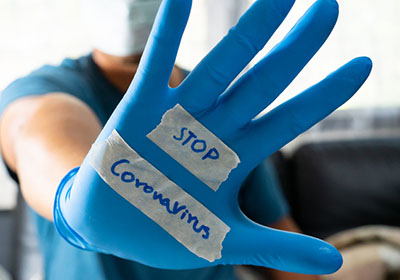
Author: Doug Dollemore
 What’s the best way to keep COVID-19 out of your life? Think like Smokey Bear, suggests Lindsay Keegan, PhD, a University of Utah Health epidemiologist.
What’s the best way to keep COVID-19 out of your life? Think like Smokey Bear, suggests Lindsay Keegan, PhD, a University of Utah Health epidemiologist.
“If you clear leaves and debris away from the campfire ring, when a spark inevitably comes out of it, there’s nothing to catch the forest on fire. That’s the idea behind physical distancing,” Keegan told listeners on KCPW earlier this week. “If we separate ourselves from big groups, the virus doesn’t have the ability to infect dozens of people at a time.”
Keegan was one of three health experts who participated in a live call-in show on the Salt Lake City public radio station that focused on what scientists are learning about the coronavirus and how to corral it. The other panelists were Emily Spivak, MD, MHS, an associate professor of medicine in the U of U Health Division of Infectious Disease, and Keegan McCaffrey, a Utah Department of Health epidemiologis
Confirmed Cases, Testing on Rise
On the day of the broadcast, Utah had 63 confirmed cases of COVID-19, primarily in Salt Lake and Summit counties. However, the panelists noted that that number is likely to expand exponentially in the coming weeks. In any case, the incidence of COVID-19 in the state is likely underestimated, according to McCaffrey, since many people with mild symptoms of the illness might not seek out medical care or be tested.
The number of Utahans being tested is on the rise, McCaffrey said. However, a shortage of chemicals needed to conduct the tests has hampered efforts to detect the illness here and elsewhere.
“While we’re ramping up testing, we’re trying to focus it on those who have real symptoms or exposure and are most likely to have the infection,” McCaffrey said. “We need to make sure we’re not essentially wasting tests on people who are likely going to be negative.”
Flattening the Curve
While the panelist weren’t sure how long physical distancing would be required, they agreed that it is the best approach to prevent the spread of the virus, at least for now. It will also prevent a surge of hospital admissions that could overwhelm the healthcare system. This strategy, known as flattening the curve, delays the peak onset of the epidemic, but spreads out cases over more time, increasing the odds that prompt and effective medical care is available, Keegan said.
For now, scientists believe the primary mode of transmission is respiratory droplets in coughs or sneezes that travel no more than six feet before it settles onto a surface. “That’s why we’re giving advice about sneezing into your elbow and staying away from each other,” Spivak said.
However, she also noted that recent studies suggest that some of these droplets can survive in the air for several hours and for days on surfaces such as cardboard, plastic and metals
For parents with young children, the panelists suggested taking them to the park at off-peak times and to wash their hands thoroughly for 20 seconds or with hand sanitizer afterward.
Although researchers are quickly learning about this virus, much remains unknown including how long after contracting the virus a person will test positive or if someone can be infected a second time after recovering from the illness.
“It’s just been absolute madness,” Keegan said of the research effort at U of U Health. “But as a scientific community, we are really coming together and producing some fantastic work on impossibly short deadlines to cope with this.”
Want to Help?
Our community is our greatest asset, and whatever help you can give, we are truly grateful for.